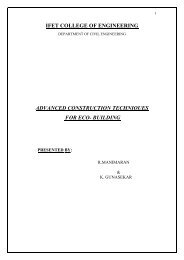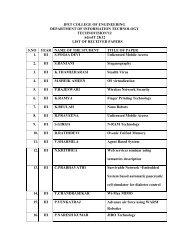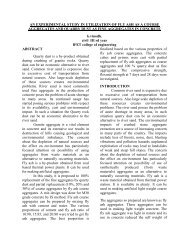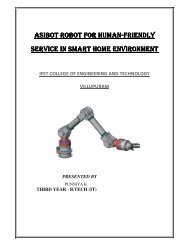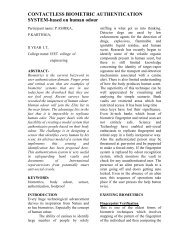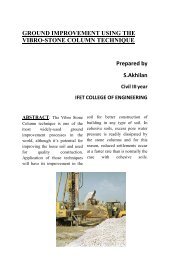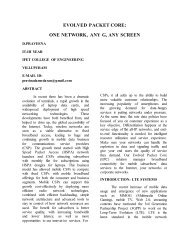precast concrete construction - IFET College of Engineering
precast concrete construction - IFET College of Engineering
precast concrete construction - IFET College of Engineering
Create successful ePaper yourself
Turn your PDF publications into a flip-book with our unique Google optimized e-Paper software.
are commonly used for floor and ro<strong>of</strong>structures in this type <strong>of</strong> <strong>construction</strong>.Slab-Column Systems with Shear WallsThese systems rely on shear walls to sustainlateral load effects, whereas the slab-columnstructure resists mainly gravity loads. Thereare two main systems in this category:• Lift-slab system with walls• Prestressed slab-column systemLift-slab systems were introduced inthe last decade <strong>of</strong> the Soviet Union (period1980-1989) in some <strong>of</strong> the Soviet Republics,including Kyrgyzstan, Tadjikistan, and theCaucasian region <strong>of</strong> Russia, etc. This type <strong>of</strong><strong>precast</strong> <strong>construction</strong> is known as “SeriaKUB.” The load-bearing structure consists<strong>of</strong> <strong>precast</strong> reinforced <strong>concrete</strong> columns andslabs, as shown in Figure 10. Precastcolumns are usually two stories high. All<strong>precast</strong> structural elements are assembled bymeans <strong>of</strong> special joints. Reinforced <strong>concrete</strong>slabs are poured on the ground in forms, oneon top <strong>of</strong> the other, as shown in Figure 11.Precast <strong>concrete</strong> floor slabs are lifted fromthe ground up to the final height by liftingcranes. The slab panels are lifted to the top<strong>of</strong> the column and then moved downwardsto the final position. Temporary supports areused to keep the slabs in the position untilthe connection with the columns has beenachieved. In the connections, the steel bars(dowels) that project from the edges <strong>of</strong> theslabs are welded to the dowels <strong>of</strong> theadjacent components and transversereinforcement bars are installed in place.The connections are then filled with<strong>concrete</strong> that is poured at the site.Most buildings <strong>of</strong> this type havesome kind <strong>of</strong> lateral load-resisting elements,mainly consisting <strong>of</strong> cast-in-place or <strong>precast</strong>shear walls, etc. In case lateral load-resistingelements (shear walls, etc.) are not present,the lateral load path depends on the ability<strong>of</strong> the slab-column connections to transferbending moments. When the connectionshave been poorly constructed, this is notpossible, and the lateral load path may beincomplete. However, properly constructedslab-column joints are capable <strong>of</strong>transferring moments as shown by severalfull-scale vibration tests performed inKyrgyzstan on buildings <strong>of</strong> this type.Another type <strong>of</strong> <strong>precast</strong> system is a slabcolumnsystem that uses horizontalprestressing in two orthogonal directions toachieve continuity. The <strong>precast</strong> <strong>concrete</strong>column elements are 1 to 3 stories high. Thereinforced <strong>concrete</strong> floor slabs fit the clearspan between columns. After erecting theslabs and columns <strong>of</strong> a story, the columnsand floor slabs are prestressed by means <strong>of</strong>prestressing tendons that pass through ductsin the columns at the floor level and alongthe gaps left between adjacent slabs (seeFigure 12). After prestressing, the gapsbetween the slabs are filled with in situ<strong>concrete</strong> and the tendons then becomebonded with the spans. Seismic loads areresisted mainly by the shear walls (<strong>precast</strong>or cast-in-place) positioned between thecolumns at appropriate locations. Thistechnology has been used in Yugoslaviaduring the last 40 years under theproprietary name, “IMS Building System,”and it can be found in all major Yugoslavcities, including such as Cuba, the




